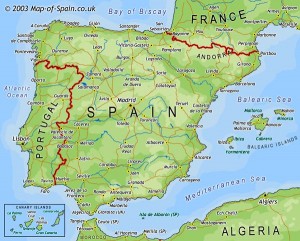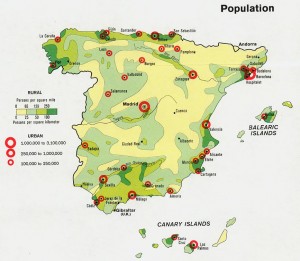 Spain Population 2013
Spain Population 2013
The current population of the Kingdom of Spain is estimated to be about 47.27 million people, which is only a 0.97% increase from the last record of population. The population of Spain has historically always been less than the populations of France and Italy. Based on the total land area and the total population of the country, the population density is estimated to be about 231 people per square mile.
Demographics of Spain
The largest ethnic group in the Kingdom of Spain is the Native Spaniard group, making up about 88% of the population. Besides Native Spaniards, however, the country consists of many minority groups of immigrants from North African, Latin American, Asia, and other European countries. The official language of the country is Spanish, which every citizen of the country is required to know Spanish. There are also a few other minor official languages as well: Basque, Catalan, and Galician. Catalan is spoken by the most amounts of people in the country other than Spanish.
Religion in Spain
The official religion of the Kingdom of Spain used to be considered Roman Catholicism. However, since the country is now a secular country, there can be no official religion. But, the Roman Catholic Church still makes up the majority of the religious population in the country. While there used to be a very large Muslim population in the country of Spain, when Roman Catholicism became the official religion, the Muslims either had to convert or to leave the country. Therefore, there are not many Muslims left in the country today, other than recent converts or immigrants.
Sports in Spain
The most popular sport in the Kingdom of Spain is football (American soccer). In fact, the Spanish national team is one of the most competitive, and some may argue, one of the best teams in the world. Spain also has many professional leagues, two of the biggest and most popular teams being Barcelona FC and Real Madrid FC. Basketball, tennis, cycling, and golf are some of the other popular sports in the country.
Spanish Cuisine
Historically Spain was divided into smaller regions, each with its own local language, culture and unique cuisine. Spain remains divided into 17 Communities, each one with its own unique cuisine including Paella, Jamon Serrano, Queso Manchego, Tapas, and Tortilla Espanola. Tapas is one of the great Spanish food traditions composed of small dishes of different types of food, similar to appetizers and snacks that most American’s are accustomed to . The dishes may be cold (jamón serrano, queso manchego, olives) or warm (tortilla española, meatballs) and can be served as bar food or as complete meals. If you have the opportunity to taste Spanish food, you will experience a whole variety of flavors and dishes.
Spain Tourism Campaign
 Historical Population of Spain
Historical Population of Spain
While the population of the Kingdom of Spain has always increased over the last half a century, the growth has had its varying degrees of growth rates. From about 1960 to around 1985, the growth of the country remained a fairly steady normal increase of population. However, from 1985 to around 1998, the growth slowed down quite a bit. Then, in 1999, the growth picked back up until about 2010 when the population growth began to really slow down.
| Year | Population (millions) |
| 1960 | 30.455 |
| 1965 | 31.723 |
| 1970 | 33.427 |
| 1975 | 35.147 |
| 1980 | 37.108 |
| 1985 | 38.273 |
| 1990 | 38.768 |
| 1995 | 39.295 |
| 2000 | 39.926 |
| 2005 | 42.345 |
| 2010 | 45.828 |
| 2011 | 46.816 |
Projected Population of Spain
The population of the Kingdom of Spain is expected to continue to increase over the next 37 years, but it will increase at a very slow rate. The birth rates are expected to remain between about 9 and 11 births per 1000 people. However, the death rates are expected to rise from about 9.7 deaths per 1000 people to about 12.6 deaths per 1000 people, exceeding the number of births per 1000 people.
| Year | Population (millions) | Percent Increase |
| 2015 | 47.321 | 0.11% |
| 2020 | 48.418 | 2.3% |
| 2025 | 49.306 | 1.8% |
| 2030 | 49.842 | 1.1% |
| 2035 | 50.380 | 1.1% |
| 2040 | 50.894 | 1.0% |
| 2045 | 51.281 | 0.76% |
| 2050 | 51.452 | 0.33% |


